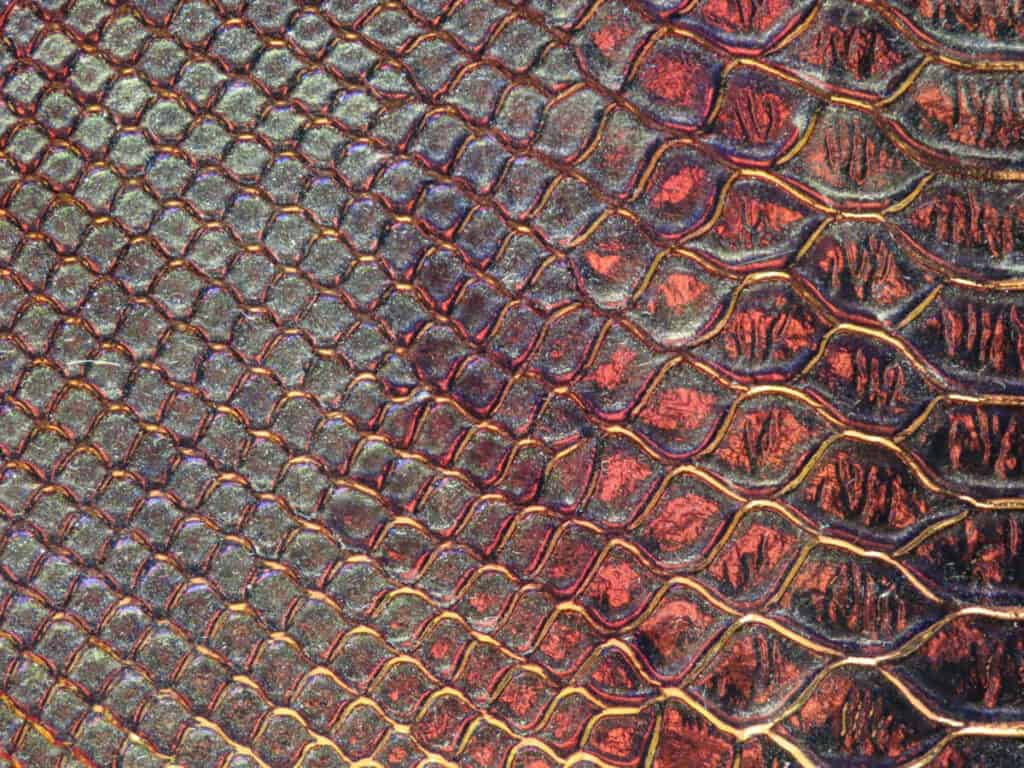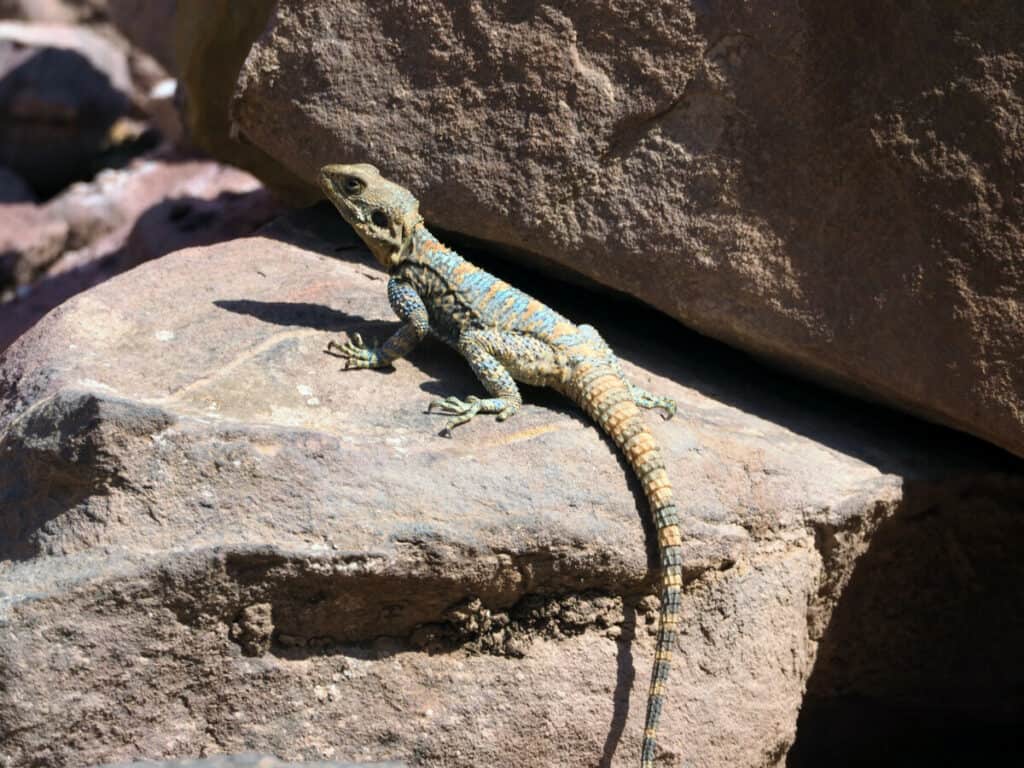
There are many species within the animal kingdom, reptiles are only one category to help us organize them in our minds. It’s safe to say that there are many different characteristics that reptiles have which set them apart from other animals.
One of the most widely known characteristics of reptiles is their scales. Depending on the reptile’s environment differ the reason for why they have scales. Mostly, they are to help protect them from predators. Reptilian scales are made out of keratin and lay in an overlapping pattern.
But do all reptiles have scales? Do they hatch with scales already?
Do all Reptiles Have Scales?
A snake, a turtle or tortoise, and crocodiles or alligators are all reptiles. But snake scales are nothing to the texture of turtles and tortoises. So do these reptiles not have scales?
Actually, they do have scales! Mainly the scales are a part of their shells, and are differentiated from scales like that of a snake or lizard by the term ‘scutes’. They serve the same function of protection, but instead of being formed on the epidermis part of a reptile’s skin, scutes are formed in a reptile’s vascular layer of skin.
They also produce a horny/boney outer layer to further protect themselves. Crocodiles and alligators also have scutes as a part of their scaly protection.
There are a few individual species of snake that do not have scales – or scutes – such as the yellow corn snake. The lack of scales in these species usually has to do with a gene mutation and would be considered as a recessive trait. If snakes with this trait mate with other snakes that also have this trait, the trait can be passed down and the strange scene continues.
These species do however have scales on their belly to help them effectively slither around, but typically that is the only place you will find scales on these types of snakes.
Most reptiles have some sort of scaly protection, even if the scales or scutes differ in size, shape, and/or quantity depending on the species and its environment.
Why Do Reptiles Have Scales?
Reptilian scales protect the animal from predators as well as water loss for those in dryer climates. It also keeps internal fluids from evaporating. However, the few species of snakes without scales, manage just fine with staying safe and retaining moisture. Just as fine as snakes with scales in the same area.
Snake’s belly scales are specifically elongated to help them crawl or climb on the various surfaces that occupy their environment, or to slither on the ground. The friction between the surface of the environment and their scales is what helps them to move quickly.
Rattlesnakes keep some of their dead/shed scales at the end of their tail in a hollowed-out area. This is what creates their infamous rattle when they vibrate their tails as a warning to predators and others to ‘back off’.
Many geckos have modified scales on the bottoms of their feet that look like little hairs that also help them with movement. These specific scales are called lamellae that allow geckos to grip and walk or run on smooth surfaces with ease. It is pretty handy if you ask me!
Reptiles Have Scales For Protection
Crocodile and alligator scales are used for protection as well as to help them stand the heat of the sun. They work kind of like solar panels in that sense. And when in the water, only part of their body where these scales or scutes are needs to be exposed to the sun to help them regulate their temperature.
When we refer to a crocodile or an alligator needing protection, it’s mainly from one another versus other animals. That is with the exception of baby and juvenile crocodilians who a very vulnerable to prey.
A turtle’s scales – or scutes – help to keep them safe from abrasions as well as keep their shell free from harmful bacteria. This is mainly true for sea turtles and tortoises but can be applied to turtles and tortoises that are on land as well.
Sea turtles also benefit from having scales since they eat jellyfish and the scutes/scales protect them from and help them to be immune to jellyfish stings. Turtles have scales on any exposed body part, for sea turtles, this includes their head whereas with land turtles it does not include their head.
Does the Environment Affect What a Reptile’s Scales are For?

While scales are not inherently affected in their purpose by the environment, different reptiles in different environments have adapted to the specific requirements there to enable them to survive.
Anacondas, for example, don’t use venom as some other snake species do. Instead, they constrict around their prey in slow suffocation. Since they have such massive bodies, they tend to hunt in the water to accommodate that, though they will still hunt on land from time to time.
When in the water, they can stay submerged for about 10 minutes while hunting. They have ligaments in their jaws as well that allow them to further trap and consume larger prey – letting them subside off of one meal for multiple weeks or even months. Since, on land, anacondas are vulnerable to parasites such as ticks they have developed a gland that has a specific scent to ward off parasites.
Lizards are another reptile that have adjusted to living comfortably in their environment – especially desert environments.
Scales Can Help Reptiles Regulate Their Temperatures
Most reptiles cannot internally regulate their temperature, which is why it’s common to see them out sunbathing. They are able to seek the warmest rays of the sun and adjust their bodily position accordingly to soak up those rays.
With cool temperatures lizards turn darker to retain heat, while in warmer to hot temperatures they turn lighter, so as to reflect sun rays and stay at a cooler temperature.
The Chameleon also has physical adaptations to their environment for hunting and staying safe and away from predators. The hood or bony structure on top of a chameleon’s head helps them to collect water to drink. It’s also used to help males gain a female’s attention to mate.
Their swiveling eyes help them to see all around them – even behind – and they can switch from vision in only one eye, to the other, or use vision from both at once.
A chameleon can change its skin color to help regulate its temperature such as lizards in the desert. However, it also helps them to camouflage within their environment to better aid them in staying safe from predators and when hunting.
Their natural skin color will depend on their environment. A chameleon also has horizontal feet to help them with gripping tree branches, making it very hard for predators to swoop in and pull them away from the branch.
Do all Reptiles Shed
All reptiles will shed their skin as they grow, and may continue to do so throughout their lifespan. Whenever the shedding process starts, the reptile will look dull due to the separation of the old skin from the new skin. Reptile shedding will differ depending on the species, environment, nutrition at the time of shedding, and the reptile’s growth rate.
Turtles – both land and sea turtles – will shed in pieces or chunks at a time. It can occur on a turtle’s neck, legs, and the scutes that are on the top and bottom part of their shell. For aquatic turtles, this can help them to avoid shell rot and other harmful parasites or bacteria they may encounter while in the water.
Lizards will also shed in pieces or chunks, and some may even eat the shed skin. Most reptiles shed from their eyes as well, except for iguanas. Shedding can happen every two weeks if the reptile grows rapidly.
Snakes typically shed in one piece, unless they are a larger snake and the skin being shed is torn at all. While it’s normally recommended to never handle a snake – especially in the wild – it’s especially true to not do so as a snake is shedding.
They tend to be irritable during this process and are more likely to strike when being handled during this time. Snakes typically shed about once a month.
Crocodiles and alligators also shed, using tree trunks or rocks to rub at and rub off dead scutes to redevelop scutes that are denser and larger as they grow in age and size. Instead of all at once like snakes, or in patches like lizards, alligators and crocodiles will shed individual scales or scutes at a time.
Snakes will shed as long as they are growing, which happens until they die, although their growth rate may slow down, and therefore they won’t shed as often. Lizards are typically the same as snakes in this regard as well, as are most reptiles.
